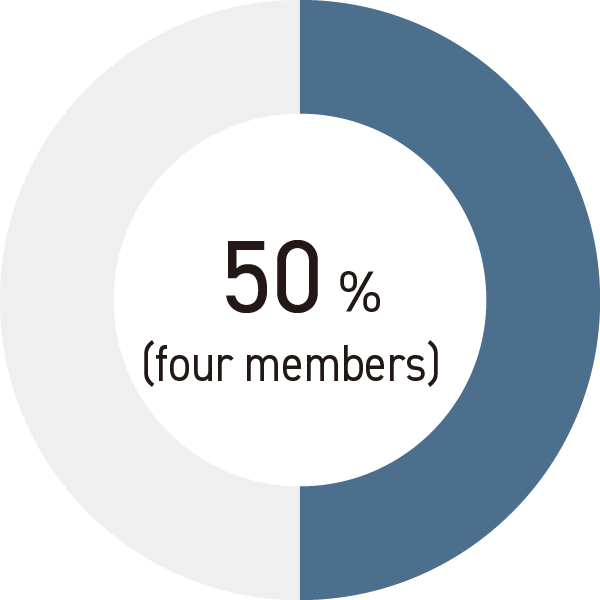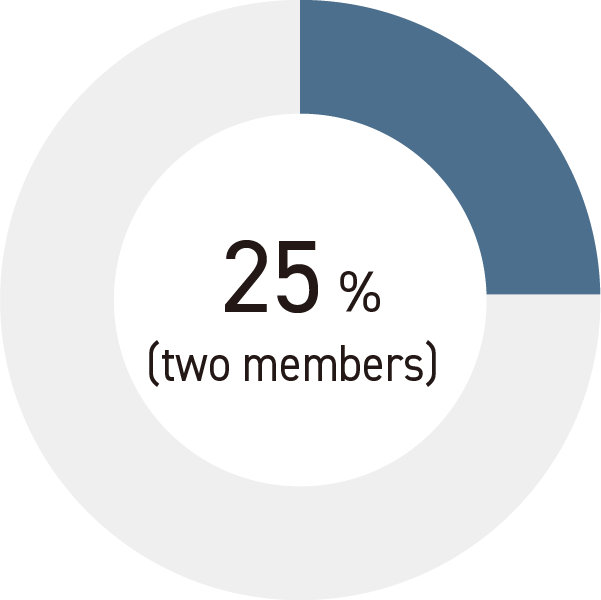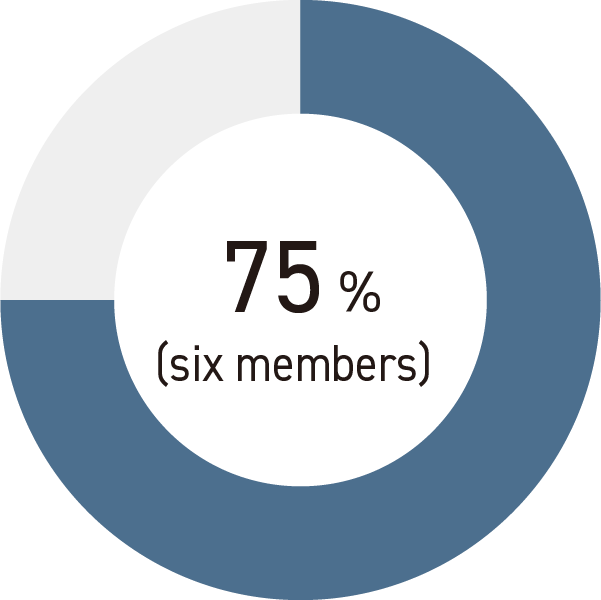Corporate Governance Structure
- Corporate Governance Structure
- Internal control & Audit systems
- Compliance
- Risk management
Basic Approach to Corporate Governance
To clarify the path toward further growth as a group amid a business environment in which volatility, uncertainty, complexity, and ambiguity (VUCA) have become the norm, we formulated our Purpose, Vision, and Long-Term Management Plan 2030 in May 2025 and are working to enhance corporate value over the medium to long term. To this end, we recognize that strengthening corporate governance is a key management priority. We are committed to building a management structure that is highly transparent, fair, and efficient, in order to fulfill our responsibilities and accountability to shareholders and other stakeholders. Accordingly, the Company has appointed multiple independent outside directors to incorporate external perspectives into the Board of Directors and enable accurate and timely decision-making. To further ensure transparency and objectivity in the nomination and compensation of directors, the Company has established the Nomination and Remuneration Advisory Committee—an independent advisory body to the Board of Directors—chaired by an independent outside director. As a Company with an Audit & Supervisory Board, the Company has established an Audit & Supervisory Board composed of a majority of outside members. In addition, the Company has formed the Management Committee to deliberate on important matters related to business execution, along with the Internal Control Committee, Risk Management Committee, and Sustainability Committee as subordinate bodies. The Audit Department serves as the internal audit function. These structures are all part of the Company’s ongoing efforts to strengthen corporate governance.
Composition of Directors
Ratio of outside officers

Ratio of female officers

Ratio of Directors with
International Business Experience

Corporate Governance Overview (As of April 1st, 2025)
- Institutional Design
- Company with Audit & Supervisory Board
- Directors
- Eight (including four outside directors)
- Chairperson of the Board of Directors
- President
- Auditors
- Three (including two outside auditors)
- Directors' term of office under the Articles of Incorporation
- One year
- Adoption of Executive Officer System
- Yes
- Directors’ Voluntary Advisory Body
- Nomination and Remuneration Advisory Committee
- [External]Accounting Auditor
- Ernst & Young ShinNihon LLC
Structure and Institutional Design

Board of Directors
The Board of Directors, comprising eight members (four of whom are outside directors), makes management decisions (management policies and plans, the appointment and dismissal of senior management, and other important business execution decisions) based on thorough discussions at regular monthly meetings and extraordinary meetings held as necessary.
| Moderator | Hiroshi Teshirogi (Representatve Director, President and CEO) |
|---|---|
| Composition |
Eight directors (four outside directors) Note: Three Audit & Supervisory Board members (including two outside members) attend meetings as observers. |
| Meetings held in fiscal 2024 | 13 |
| Main Roles and Authorities |
Note: The execution of business operations that do not require decisions by the Board of Directors is delegated to executive officers and other senior management members in accordance with internal regulations. |
Nomination and Remuneration Advisory Committee
The Nomination and Remuneration Advisory Committee is an advisory body to the Board of Directors composed of two outside officers (with one outside officer appointed as chairman) and one full-time internal director. The committee deliberates on matters that include succession plans for the chief executive officer; the nomination of directors, executive officers, and other management positions involving business execution; and remuneration.
| Chairperson | Yukino Kikuma(Outside Director)
Note: She succeeded former Outside Director Masao Hisada at the Board of Directors meeting in June 2025. |
|---|---|
| Composition | Internal directors: One member (full-time) Outside officers: Two members |
| Meetings held in fiscal 2024 | 10 |
| Main role and authority |
|
Audit & Supervisory Board
The Audit & Supervisory Board, composed of three members (including two outside Audit & Supervisory Board members), holds regular monthly meetings and convenes extraordinary meetings as necessary. It deliberates on reports from each member and formulates audit opinions as a board. The Audit & Supervisory Board also regularly exchanges views and shares information with the Accounting Auditor and the Audit Department to ensure close coordination.
| Chairperson |
Junichi Kitagaki(full-time) |
|---|---|
| Composition | Internal Audit & Supervisory Board members: One member (full-time) Outside Audit & Supervisory Board members: Two members |
| Meetings held in fiscal 2024 | 13 |
| Main role and authority |
|
Management Committee
The Management Committee meets once a month, attended by four internal directors and one full-time Audit & Supervisory Board member as an observer, to conduct advance deliberations on important matters related to business execution, capital policy, corporate organization, strategic risks, and other matters requiring resolutions or reports by the Board of Directors.
Executive Committee
The Executive Committee consists of four internal directors, all four of whom concurrently serve as executive officers, seven other executive officers, Manager of Osaka branch, Manager of Nagoya branch, General Manager of Audit Dept. and one full-time Audit & Supervisory Board member who participates as an observer.
Executive Division Committees (As of April 1st ,2025)
| Committee name | Chair and frequency of meetings | Specific role |
|---|---|---|
| Risk Management Committee | Chair: Director, Managing Executive Officer and CFO |
|
|
Credit Risk Subcommittee |
|
|
|
Insurance Subcommittee |
|
|
|
Market Risk Subcommittee |
|
|
|
Business Succession Subcommittee |
|
|
|
Security Trade Control Subcommittee |
|
|
|
Investment and Financing Subcommittee |
|
|
| Internal Control Committee | Chair: Director, Managing Executive Officer(in charge of internal controls) |
|
|
Compliance Meeting |
|
|
|
Information Management |
|
|
| Sustainability Committee | Chair: Senior Managing Executive Officer and CSO |
|
Evaluation of the Effectiveness of the Board of Directors
Evaluation of the Effectiveness of the Board of Directors
Once a year, we conduct a survey of all directors and Audit & Supervisory Board members who are members of the Board of Directors to identify issues related to the effectiveness of the Board of Directors, which are then evaluated and analyzed. The effectiveness evaluation survey for FY2025 (April 1, 2024–March 31, 2025) was conducted from late January to mid-February 2025, with all directors and Audit & Supervisory Board members asked to respond directly to an external organization. The survey results showed improvement in two of the FY2025 focus areas: “deepening discussions on the preconditions necessary for formulating management strategies and plans consistent with corporate value enhancement over the medium to long term” and “provision of training opportunities for officers.” However, the remaining two items showed no improvement. Based on the results, these items—together with others that received relatively lower evaluations—were designated as key improvement areas for FY2026.
Issues identified in the fiscal 2022 Board of Directors’ effectiveness evaluation survey and progress of efforts to resolve them
Main topics covered in the fiscal 2023 survey
- Composition, operation, and discussions of the Board of Directors
- The Board’s monitoring function
- Performance of internal directors
- Performance of outside directors
- Support framework for directors and Audit & Supervisory Board members
- Provision of training opportunities for officers
- Dialogue with shareholders (investors)
- Officers’ individual efforts
- Overall assessment
Evaluation of the effectiveness of the Board of Directors in FY2025 / Issues identified based on the results of the survey to be addressed in FY2026
Appointment and Dismissal of Directors
Appointment and Dismissal of Directors
In line with the selection criteria for candidates for the Board of Directors, internal candidates must have a wide range of knowledge and a wealth of experience related to ALCONIX business management, while outside candidates must meet Tokyo Stock Exchange requirements for independent officers and possess practical, objective perspectives and deep insight that meet the criteria for determining independence as defined by ALCONIX. Regarding the appointment and dismissal of directors and the nomination of director candidates, the Nomination and Remuneration Advisory Committee makes an overall evaluation of candidates with the potential for executing duties appropriately as a director who satisfy requirements in terms of the knowledge, experience, capabilities, and accomplishments required for each position, with recommendations forwarded to the Board of Directors for resolution.
Officer Remuneration System
Officer Remuneration System
The Company's basic policy regarding executive compensation and the amount of compensation for individual officers are determined by the resolution of the Board of Directors, after these matters have been deliberated by the Nominating and Compensation Committee established as an advisory body to the Board to ensure their objectivity and transparency. The Committee takes into consideration as much as possible the business environment outlook for the Group and the latest thinking regarding corporate governance codes in Japan in deliberating the policies and evaluation criteria below.
Basic Principles for Remuneration (Excluding Outside Directors)
Remuneration as a Means to Support Sustainable Value Creation for the Group
-
1) Remuneration is set at a level that provides a healthy degree of motivation to promote sustainable growth and corporate value creation over the medium to long term.
-
2) Performance-linked remuneration is granted fairly and equitably and is determined via a uantitative evaluation based on financial performance, and a qualitative evaluation based on the recipient’s efforts to address issues in accordance with the Company’s medium- to long-term strategy, the extent of decision-making regarding the appropriate allocation of management resources from a medium- to long-term perspective, and the extent of decision-making regarding investments (M&As, capital investments, etc.) based on appropriate risk-taking. This method ensures that the Group’s management is aware of their responsibility for the operating results for each fiscal year.
-
3) Continuous long-term incentives linked to medium- to longterm performance of the Group are granted with the goal of creating sustainable corporate value.
-
4) The Group promotes long-term stock ownership while such remuneration serves to ensure that its recipient, i.e., a director, maintains a shared interest with other shareholders.
Ensuring Objective and Transparent Remuneration Decisions
-
1) The policy for determining remuneration, as well as amounts paid to individual directors is deliberated upon by the Nomination and Remuneration Advisory Committee, of which the majority is outside officers.
-
2) We ensure that remuneration is set at an appropriate level by referencing survey data from external research organizations, making objective verifications, such as comparing levels with other companies in the same industry or of the same size, and taking into consideration the characteristics of the Group’s business.
Remuneration System
Remuneration for directors (excluding outside directors) comprises fixed remuneration and performance-linked remuneration, which is provided as monetary remuneration, performance-linked stock remuneration(BBT=Board Benefit Trust), in which Company stock is provided in light of sustainable creation of corporate value, and restricted stock remuneration, which is aimed at maintaining a sense of shared value with shareholders through the continued holding of Company stock.
-
1) Composition of Fixed Remuneration
- Supervisor salary
- Fixed remuneration is granted, taking into account a director’s supervisory function (uniform for all) and the degree of responsibility placed upon representatives (representative directors only).
- Executive salary
- Fixed remuneration is granted according to a director’s position (payment for executive duties) plus fixed remuneration according to the role that C-suite executives play in business execution, when applicable.
-
2) Composition of Performance-Linked Remuneration
In addition to fixed remuneration, performance-linked remuneration is granted as a percentage of the executive salary granted for executive duties, ranging from 0–100%.
The amount for each director is determined by the degree to which the Group achieved its consolidated ordinary profit, Total Shareholder Return(TSR) and ROE targets for the fiscal year, both of which are key indicators from a management perspective, and by qualitative contributions by the individual director. This method clarifies responsibility toward operating results for each fiscal year. -
3) Structure of the Board Benefit Trust (BBT)
- Points are granted according to position in accordance with the Company's Officer Stock Benefit Regulations, based on the achievement rate of numerical performance targets during the performance evaluation period.
- The right to receive benefits is determined after the conclusion of the Ordinary General Meeting of Shareholders held following the end of the three fiscal years covered by the performance evaluation period.
- Treasury shares contributed by the Company and cash equivalent to the market value of those shares are provided through the trust.
-
4) Restricted stock compensation
- This is a long-term incentive system aimed at sustainably enhancing corporate value. Under the program, directors and officers (excluding outside officers) contribute the full amount of their monetary compensation claims as in-kind contributions, within a pre-approved overall remuneration limit (both amount and number of shares), in exchange for newly issued or treasury shares of the Company’s common stock.
- The transfer restrictions will be lifted upon fulfillment of such conditions as: the expiration of the transfer restriction period, or resignation or retirement from any position—including director, executive officer, employee, or other equivalent role designated by the Company’s Board of Directors—prior to the expiration of the transfer restriction period, due to reasons such as expiration of term of office, death, or other grounds deemed legitimate by the Board of Directors.
Total Remuneration Amount for Each Officer Classification, Total Remuneration Amount by Type, and Number of Applicable Officers(Fiscal 2024)
| Officer classification |
Total remuneration amount (million yen) |
Total remuneration amount by type (million yen) |
Number of applicable officers |
||
|---|---|---|---|---|---|
| Fixed remuneration | Performance-linked remuneration | Non-monetary remuneration | |||
| Directors (excluding outside directors) |
251 | 187 | 41 | 22 | 5 |
| Audit & Supervisory Board members (excluding outside members) |
26 | 26 | − | − | 1 |
| Outside officers | 76 | 76 | − | − | 8 |
Note: The amount paid to directors includes the remuneration for executive officers who also serve as directors.
Basic Policy for Determining Remuneration for Outside Directors
Remuneration for outside directors performing their supervisory function independent of business execution is limited to fixed remuneration (supervisor salary).
This amount is set after comparison with companies in the same industry or of the same size as ALCONIX. The Nomination and Remuneration Advisory Committee deliberates over the remuneration amount for outside directors and then drafts a proposal for a total amount within the limit approved at the Ordinary General Meeting of Shareholders. This proposal is submitted to the Board of Directors for approval. (As a general rule, remuneration of outside directors does not change, regardless of the number of years they have served. However, the chair of the Nomination and Remuneration Advisory Committee and its members receive a separate payment for committee membership.)
Cross-shareholding Policy
Cross-shareholding Policy
The ALCONIX cross-shareholding policy aims to facilitate business relationships and strengthen corporate alliances. Cross shareholdings account for 4.9% of total consolidated assets (5.4% including unlisted shares), the details of which are provided in the Corporate Governance Status section of the annual Securities Report. Regarding ALCONIX cross-shareholdings, we examine performance, financial conditions, and business transactions of each investee company to determine whether it is appropriate to continue holding company shares, whether the benefits of holding company shares are commensurate with the cost of capital and other important management indicators, and whether strengthening business relationships with suppliers and customers will contribute to ALCONIX sustainable growth and the medium- to long-term enhancement of corporate value. After thorough reviews are conducted by the Risk Management Committee and the Management Committee, the Board of Directors determines the rationale behind continued cross-shareholdings, and if the significance of these holdings declines, the Board’s policy is to engage the counterparty in dialogue and reduce the number of shares held or otherwise dispose of said shares. In exercising cross-shareholding voting rights, the Board of Directors examines all proposal details, scrutinizes whether they are in line with enhancing the corporate value of the investee company, and votes for or against each proposal, as appropriate.



